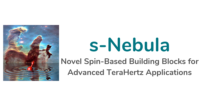Researchers from the s-Nebula consortium will present a special symposium during the next CLEO conference

Big news for s-Nebula, Tobias Kampfrath, Freie Universität Berlin (FUB), Romain Lebrun, Thales, Mathias Vanwolleghem, Institut d’Electronique, de Microélectronique et de Nanotechnologie IEMN, (CNRS), and Tom Seifert, Freie Universität Berlin (FUB), are among the organisers of a special symposium during the next CLEO conference entitled “Hot topics in THz Photonics: Spintronics and Biophotonics”.
The CLEO conference is the biggest conference about laser and photonics applications in the world. Due to the COVID crisis, the event will be held online this year from 9 May to 14 May. The symposium will take place on 10 May at 13:00 (UTC).
The s-Nebula team will take part in the first part of the symposium: Spintronics and Ultrafast Magnetism: New Paradigms for Novel Terahertz Sources and Detectors.
During the conference, Tom Seifert will talk about “Exploiting Ultrafast Spintronics for Terahertz Photonics” and two young PhD researchers participating in the project will also make a presentation.
Geoffrey Lezier, PhD at IEMN-CNRS (CNRS) will speak about “Coherent Polarization Rotation of TeraHertz Spintronic emitters with in-plane uni-axial magnetic anisotropy”.
Enzo Rongione, PhD at CNRS-Thales (CNRS) will speak about “Efficiency of THz Spintronic emitters: from Spin-Hall effect in 3D metals to surfaces states in topological insulators”.
You can find below an abstract of the work that will be discussed during the symposium:
Following the demonstration in 2015 of THz TDS of sub-100fs spin dependent electron scattering in GMR devices, the “reciprocal” effect was quickly discovered, i.e. the generation of ultrabroadband THz pulses generated by fast spin currents in ferromagnetic metallic heterostructures due to the inverse spin Hall effect (ISHE). These results, have led to the appearance of THz spintronics as an active thematic where first practical applications and disruptive technological breakthroughs are being reported. Today pulsed spintronic emitters are competing with photoconductive switches or nonlinear crystals, without being hindered by phonon absorption. They might therefore become key in the spectral range between 1-15 THz where now only cryo-cooled THz QCL’s or bulky gas lasers are available. This special symposium aims at providing a forum for discussing the various recent developments in generating (and detecting) THz through spintronic mechanisms. This includes not only spin-orbit interfaces exploiting spin-Hall effects or Rashba surface states, but also electrically controlled THz coherent oscillations in antiferromagnetic systems. Beyond the description of new fundamental phenomena, aspects such as power optimization, narrowband CW generation, tunability, modulation and polarization control by magnetic anisotropy or magnetoelasticity will be addressed, as well as applications in spectroscopy, ellipsometry, near-field imaging, or testing.
